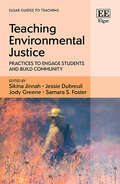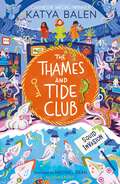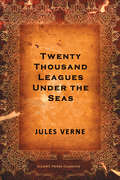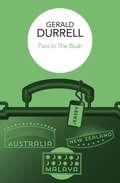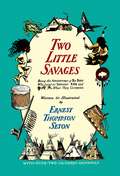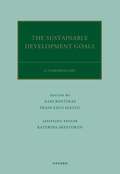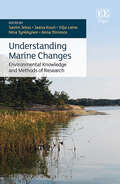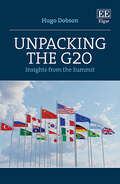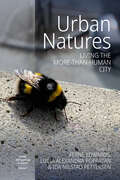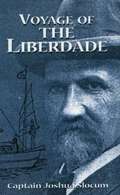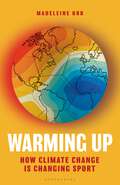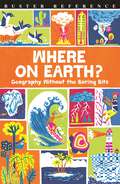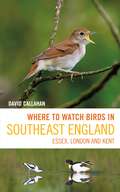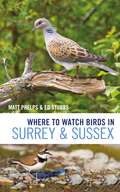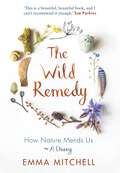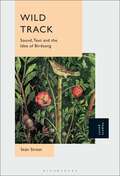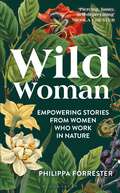- Table View
- List View
Teaching Environmental Justice: Practices to Engage Students and Build Community (Elgar Guides to Teaching)
This ground-breaking book presents interdisciplinary educators with classroom tools and strategies to integrate environmental justice into their courses. Providing accessible, flexible, and evidence-based pedagogical approaches designed by a multidisciplinary team of scholars, it centers equity and justice in student learning and course design. It further presents a model for community-based faculty development that can communicate those pedagogical approaches across disciplines.Key Features:Reflection on how to teach inclusively across disciplines, with a focus on community-based faculty development.Presentation of a blend of insights from diverse disciplines, including art, astronomy, ecology, economics, history, political science, and online education.A focus on how to stimulate student engagement to improve students’ empirical and conceptual understanding of environmental politics.Detailed instructions for both introductory and more advanced active learning assignments and classroom activities, including guidance on how to manage common challenges and adapt activities to specific learning environments, particularly online formatsProviding detailed instructions and reflections on teaching effectively and inclusively, Teaching Environmental Justice will be an invaluable resource for faculty and graduate students teaching modules in environmental justice in courses across disciplines. It will also be essential reading for researchers of teaching and learning seeking insight into cutting-edge classroom practices that center equity and justice in student learning.
Termites and heritage buildings: A study in integrated pest management
by Brian RidoutThe last overview of termites for the non-specialist was published several decades ago and in the intervening years, both knowledge, and the termites themselves have moved on. A 27-year eradication effort for one termite infestation in Devon has shown that UK structures are becoming vulnerable as the climate changes and also that extermination of a colony can be difficult even when there are no other termites waiting to invade. Heritage buildings often present even more problems. Survey work and treatments may be complicated by structural and material complexity overlain with a requirement to retain as much undisturbed and original fabric as possible. There will be concealed cavities not inspected, and inserted barriers, both chemical and physical, will inevitably be incomplete. This study discusses the modifiable environmental parameters that govern termite activity and offers a resume of the baits and chemical treatments that have been developed so that the most appropriate can be selected where necessary. It is primarily intended for those involved in conservation, both in the UK and elsewhere, who commonly have limited resources. It is hoped that it will also be of use to architects, surveyors and others with an interest in Heritage structures.
The Thames and Tide Club: Squid Invasion
by Katya BalenThe mudlarkers of the Thames and Tide Club are about to face Squidmageddon in a funny and fast-paced adventure for young treasure hunters. When the director of the mudlarking museum goes on holiday for a week, he leaves three members of the Thames and Tide Club – Clem, Zara and Ash – in charge. They're determined that nothing will go wrong on their watch, but they haven't planned on an invasion of squid who will stop at nothing to take over the world … Join the club and dig for treasure in the wildest adventure you could imagine!
Travels in the Interior of America
by John BradburyInteresting notes about the country in early times.
Twenty Thousand Leagues Under the Seas: An Underwater Tour of the World
by Jules Verne F. P. WalterTwenty Thousand Leagues Under the Sea: A Tour of the Underwater World is a classic science fiction adventure novel by French writer Jules Verne published in 1870. While investigating reports of a sea monster off the coast of New York, Professor Pierre Aronnax instead discovers adventure in the depths of the ocean with Captain Nemo and the crew of the submarine Nautilus.
Two in the Bush (El\libro De Bolsillo Ser.)
by Gerald DurrellTwo in the Bush is a record of the six-month journey which took Gerald Durrell, his wife Jacquie, and two cameramen through New Zealand, Australia and Malaya. The object was, first, to see what was being done about the conservation of wild life in these countries, and, secondly, to make a series of television films for the BBC. They were introduced to many rare and remarkable animals – Royal Albatrosses, Tuataras, Duck-Billed Platypuses, Flying Lizards and Long-Nosed Bandicoots, as well as to some equally unusual humans. Anyone who has read The Overloaded Ark, The Bafut Beagles or The Whispering Land will have enjoyed Gerald Durrell’s enthusiastic adventuring and his delight in the absurdity of the situations in which he finds himself. His observation of animal – and human – behaviour is always informative and often hilarious. ‘Delightfully readable and often very funny.’ Daily Mail ‘An account of Gerald Durrell’s tour of New Zealand, Australia and Malaya in search of rarities . . . Easy to read, difficult to put down, with many vivid sidelights on the human side of the expedition. This absorbing narrative reveals the ardours, ironies and disappointments, the organizational miracles and the hilarious human mishaps . . .’ Maurice Wiggin, Sunday Times ‘Mr Durrell has the knack of writing about animals and their antics with tremendous affection and enthusiasm, but without sentimentality.’ Sunday Telegraph ‘Will delight his fans and armchair naturalists everywhere.’ Evening Standard
Two Little Savages: Being the Adventures of Two Boys Who Lived as Indians and What They Learned
by Ernest Thompson SetonThis is one of the great classics of nature and boyhood by one of America's foremost nature experts. It presents a vast range of woodlore in the most palatable of forms, a genuinely delightful story. It will provide many hours of good reading for any child who likes the out-of-doors, and will teach him or her many interesting facts of nature, as well as a number of practical skills. It will be sure to awaken an interest in the outdoor world in any youngster who has not yet discovered the fascination of nature.The story concerns two farm boys who build a teepee in the woods and persuade the grownups to let them live in it for a month. During that time they learn to prepare their own food, build a fire without matches, use an axe expertly, make a bed out of boughs; they learn how to "smudge" mosquitoes, how to get clear water from a muddy pond, how to build a dam, how to know the stars, how to find their way when they get lost; how to tell the direction of the wind, blaze a trail, distinguish animal tracks, protect themselves from wild animals; how to use Indian signals, make moccasins, bows and arrows, Indian drums and war bonnets; how to know the trees and plants, and how to make dyes from plants and herbs. They learn all about the habits of various birds and animals, how they get their food, who their enemies are and how they protect themselves from them.Most of this information is not generally available in books, and could be gained otherwise only by years of life and experience in suitable surroundings. Yet Mr. Thompson Seton explains it so vividly and fully, with so many clear, marginal illustrations through the book, that the reader will finish "Two Little Savages" with an enviable knowledge of trees, plants, wild-life, woodlore, Indian crafts and arts, and survival information for the wilds. All of this is presented through a lively narrative that has as its heroes two real boys, typically curious about everything in the world around them, eager to outdo each other in every kind of endeavor. The exciting adventures that befall them during their stay in the woods are just the sort of thing that will keep a young reader enthralled and will stimulate his or her imagination at every turn.
The UN Sustainable Development Goals: A Commentary (Oxford Commentaries on International Law)
by Ilias Bantekas Francesco SeatzuIn September 2015, the United Nations General Assembly adopted the 17 Sustainable Development Goals (SDGs). This historic document constituted a transformative 'plan for action for people, planet and prosperity' with regards to the sustainable development efforts of all countries. The Sustainable Development Goals serves as an expert compendium, the most authoritative ready-reference tool for anyone interested in the SDGs. Each chapter comprises a detailed target-by-target analysis of one of the SDGs, including a methodical analysis of the preparatory proceedings that shaped each goal in its present form, an exhaustive examination of their content, and a critical assessment from an international law perspective. This commentary provides readers with the most up-to-date information on normative and legal questions arising from the incorporation of the SDGs into the international economic, social, and environmental legal frameworks, and on their implementation status. Scholars, practitioners, and those interested in the fields of law, politics, development, economics, environmental studies, and global governance will find this book a must-read.
Understanding Marine Changes: Environmental Knowledge and Methods of Research
Studying environmental changes to the seas and oceans through a variety of perspectives and disciplines, this pioneering book outlines the challenges of researching marine environmental issues.With no linear cause-and-effect relationship between marine environmental changes and the often human-induced stressors which produce them, the changes to our seas and oceans are complex and uncertain, arising from multiple and interconnected issues. Bringing together academic expertise from different fields of study, this innovative book engages with stakeholders and branches of local ecological knowledge to address marine changes, outlining how they must be studied from multiple perspectives rather than a single academic discipline to reach effective solutions. Discussing marine interdisciplinarity in action, the book features international case studies from diverse fields across the ocean sciences, humanities and social sciences that explore art and science collaborations in practice.Showcasing the practical challenges and opportunities of such research, this will prove an invigorating read for students and scholars across such subject areas as environmental governance and regulation, marine and ocean sciences, sustainability studies and climate change. Its findings will also be of use to policymakers and practitioners concerned with marine changes across the world.
Understories: Plants and Culture in the American Tropics (American Tropics: Towards a Literary Geography #9)
Understories: Plants and Culture in the American Tropics establishes the central importance of plants to the histories and cultures of the extended tropical region stretching from the U.S. South to Argentina. Through close examination of a number of significant plants – cacao, mate, agave, the hevea brasilensis, kudzu, the breadfruit, soy, and the ceiba pentandra, among others – this volume shows that vegetal life has played a fundamental role in shaping societies and in formulating cultural and environmental imaginaries in and beyond the region. Drawing on a wide range of cultural traditions and forms across literature, popular music, art, and film, the essays included in this volume transcend regional and linguistic boundaries to bring together multiple plant-centred histories or ‘understories’ – narratives that until now have been marginalized or gone unnoticed. Attending not only to the significant influence of humans on plants, but also of plants on humans, this book offers new understandings of how colonization, globalization, and power were, and continue to be, imbricated with nature in the American tropics.
Unpacking the G20: Insights from the Summit
by Hugo DobsonWith a novel focus on the individual members of the G20, this innovative book explores the perspectives and behaviours of those within the global summit, unpacking what they are seeking to achieve, how they go about doing this, and the domestic impact of the G20.Providing insights from the summit, Hugo Dobson comprehensively analyses the G20’s development and practices from the perspectives of the nineteen member states and one inter-governmental organisation that have shaped it. Chapters examine members’ reactions to the upgrading of the G20 to a summit of leaders in 2008, its development thereafter into the premier forum for international economic cooperation, and the expansion of its agenda beyond macroeconomic issues to a range of global collective action problems. Looking at its future from a country-specific perspective, Dobson concludes that the G20 will continue to engage with stakeholders and evolve in terms of its membership, as seen in the decision at the 2023 Delhi summit to include the African Union, thereby providing a basis for future research on its members’ perspectives, positions and behaviours.This multidisciplinary book will be an invigorating read for students of international relations and politics, global governance, sustainable development, climate change and energy transitions, and security and terrorism. Its exclusive insights will also be of use to policymakers and third sector organisations who are stakeholders in the G20 process.
Urban Natures: Living the More-than-Human City (Urban Anthropology Unbound #1)
Efforts to create greener urban spaces have historically taken many forms, often disorganized and undisciplined. Recently, however, the push towards greener cities has evolved into a more cohesive movement. Drawing from multidisciplinary case studies, Urban Natures examines the possibilities of an ethical lively multi-species city with the understanding that humanity’s relationship to nature is politically constructed. Covering a wide range of sectors, cities, and urban spaces, as well as topics ranging from edible cities to issues of power, and more-than-human methodologies, this volume pushes our imagination of a green urban future.
Urban Natures: Living the More-than-Human City (Urban Anthropology Unbound #1)
by Ferne Edwards Lucia Alexandra Nbsp Popartan Ida Nilstad PettersenEfforts to create greener urban spaces have historically taken many forms, often disorganized and undisciplined. Recently, however, the push towards greener cities has evolved into a more cohesive movement. Drawing from multidisciplinary case studies, Urban Natures examines the possibilities of an ethical lively multi-species city with the understanding that humanity’s relationship to nature is politically constructed. Covering a wide range of sectors, cities, and urban spaces, as well as topics ranging from edible cities to issues of power, and more-than-human methodologies, this volume pushes our imagination of a green urban future.
Voyage of the Liberdade
by Joshua SlocumIn 1890, the author became the first person to circumnavigate the globe alone. This is the account of one of his lesser-known but no less remarkable sea journeys. From the Publisher: Great 19th-century mariner's thrilling, account of the wreck of his ship off the coast of South America, the 35-foot brave little craft he built from the wreckage, and its remarkable, danger-fraught voyage home. A 19th-century maritime classic brimming with courage, ingenuity, and daring. Easy-to-read and fast-paced.
Warming Up: How Climate Change is Changing Sport
by Madeleine OrrThe world of sport has a new opponent: climate change.In recent years, a world championship marathon was held at midnight to avoid the blistering sun. Professional athletes needed oxygen tanks to play during wildfire season in California. Players collapsed and play was suspended amid the heat and bushfire smoke at the Australian Tennis open. Ski resorts in the Alps have turned into ghost towns. Golf courses are sinking into the sea. And then there's the Qatar World Cup, among the greatest follies in sporting history, one that saw hundreds (perhaps thousands) of heat-induced deaths before a ball was even kicked. The threat climate change poses to sport is clear, but with billions of participants and fans around the world who rely on the sector for entertainment, jobs, fitness and health, this is one industry we can't afford to lose. In this book, Madeleine Orr shows it doesn't have to be this way. There are ways to mitigate, and perhaps counter, even the worst elements of climate change. A world-leading sport ecologist, Madeleine interviews athletes, coaches, politicians and thought-leaders to learn more about the inevitable consequences for this trillion-dollar industry. From the frontlines of climate change, Warming Up takes readers through a play-by-play of how global warming is already impacting sport, and how the sports world can fight back.
Where On Earth?: Geography Without the Boring Bits
by James DoyleWhere on Earth? is jam-packed with all of geography's greatest hits, with all the boring bits taken out. From how to make a raindrops to cool ways to remember the world's wonderful waterfalls, longest rivers and most desolate deserts - plus all the countries and continents in which these fantastic features are found. The perfect learning companion to help all school children get to grips with discovering the world around them.
Where to Watch Birds in Southeast England: Essex, London and Kent (Where to Watch Birds)
by David CallahanThe definitive site guide to a surprisingly bird-rich corner of England – Kent, Essex and the Greater London area.From the deep forests of Kent to the low-lying mudflats, beaches and saltmarshes of the Greater Thames Estuary, this ecologically rich area of England attracts vast numbers of wildfowl and waders. The region boasts many internationally and nationally important reserves including Rainham Marshes and Cliffe Pools, while Dungeness in Kent is one of Britain's best known birding hotspots for vagrant species such as Penduline Tit and Kentish Plover. London itself contains numerous birdwatching sites including Barnes and Woodberry Wetlands, along with some of the best spots in Britain for scarcities such as Lesser Spotted Woodpecker and Black Redstart. From Marsh Harrier and Firecrest to Curlew and Lapwing, there is plenty for birdwatchers to enjoy while exploring the parks, wetlands, woodlands and coast of southeast England. Written by life-long birdwatcher David Callahan, this is the definitive guide to the birding highlights of the region. It contains a comprehensive review of all the major sites and many lesser-known ones, with maps, notes on access, and information on target species and when to visit. Where to Watch Birds in Southeast England is indispensable for any birder exploring the region, or anyone in London wanting to head out to the countryside and enjoy a slice of our rich avian heritage.
Where to Watch Birds in Surrey and Sussex (Where to Watch Birds)
by Matthew Phelps Ed StubbsThis site guide covers the counties of East Sussex, West Sussex and Surrey, including sites in southwest Greater London. From the heaths of Surrey to the chalky grassland of the North and South Downs, the great forests of the Weald and the headlands, shingle beaches and river valleys of England's south coast, these three counties are a bird-rich part of the country, with perhaps the most diverse range of habitats in the country, and all within easy distance of London, the southwest part of which contains birding sites such as Barnes wetland centre.This new book by Matthew Phelps and Ed Stubbs is the definitive guide to the birding highlights of the region. It contains a comprehensive review of all the major sites, and many lesser-known ones, with maps, notes on access, and information on target species and when to visit. Where to Watch Birds in Surrey and Sussex is indispensable for any birder heading to this bird-rich region, or anyone in London who wants to head south to enjoy some of the best birding England can offer.
The Wild Remedy: How Nature Mends Us - A Diary
by Emma MitchellTHE SUNDAY TIMES BESTSELLER Emma Mitchell's richly illustrated and evocative diary records her nature finds over the course of a year and shows how being in the wild benefits our mental and physical wellbeing. 'This is a beautiful, beautiful book, I can't recommend it enough.' Sue Perkins_________________________‘Profound, inspiring and exquisite.’ Emma Freud_________________________‘Precise, gorgeous and inspiring.’ Amy Liptrot _________________________Emma Mitchell has suffered with depression – or as she calls it, 'the grey slug' – for twenty-five years. In 2003, she moved from the city to the edge of the Cambridgeshire Fens and began to take walks in the countryside around her new home, photographing, collecting and drawing as she went. In Emma's hand-illustrated diary, she takes us with her as she follows the local paths and trails, sharing her nature finds over the course of a year. Reflecting on how these encounters impact her mood, Emma's candid account of her own struggles is a powerful testament to how reconnecting with nature can be as medicinal as any talking therapy or pharmaceutical.Written with Emma's characteristic wit and frankness, and filled with her beautiful drawings, paintings and photography, this is a truly unique book for anyone who has ever felt drawn to nature and wondered about its influence over us.
Wild Track: Sound, Text and the Idea of Birdsong
by Seán StreetWild Track is an exploration of birdsong and the ways in which that sound was conveyed, described and responded to through text, prior to the advent of recording and broadcast technologies in the late 19th and early 20th centuries. Street links sound aesthetics, radio, natural history, and literature to explore how the brain and imagination translate sonic codes as well as the nature of the silent sound we "hear" when we read a text. This creates an awareness of sound through the tuned attention of the senses, learning from sound texts of the natural world that sought – and seek – to convey the intensity of the sonic moment and fleeting experience. To absorb these lessons is to enable a more highly interactive relationship with sound and listening, and to interpret the subtleties of audio as a means of expression and translation of the living world.
Wild Woman: Empowering Stories from Women who Work in Nature
by Philippa ForresterAn engaging blend of conservation stories and humorous, personal anecdotes from Philippa Forrester about women who, like her, choose to live and work in the wild.Surviving in the wilderness has long been associated with men, and conservation and environmental biology have traditionally been male-dominated subjects. Yet many remarkable women also choose to live and work in wild and challenging landscapes. In Wild Woman, Philippa Forrester considers the grit and determination required for women to maintain connections to wildlife and shares stories of female conservation heroes and other extraordinary wild women working in nature. Talking to women from around the world, Philippa studies and celebrates what it means to be a wild woman. From the sixteenth-century botanist who was the first woman to circumnavigate the globe to modern-day women responding to bear attacks in Yellowstone, working to rewild reserves in South Africa, photographing Caribou in the Arctic and more, Philippa examines how these women benefit from a life spent in the wilderness and also considers what the natural world gains from them. Relating some of her own experiences from three decades spent travelling around the world and working in some of the wildest places on Earth, Philippa asks: what does it take for a woman to live or work in the wild?
